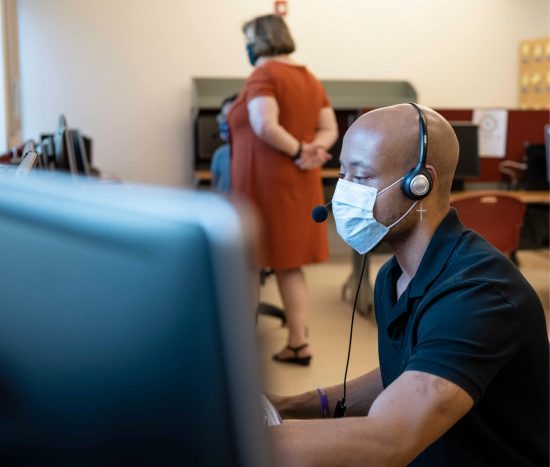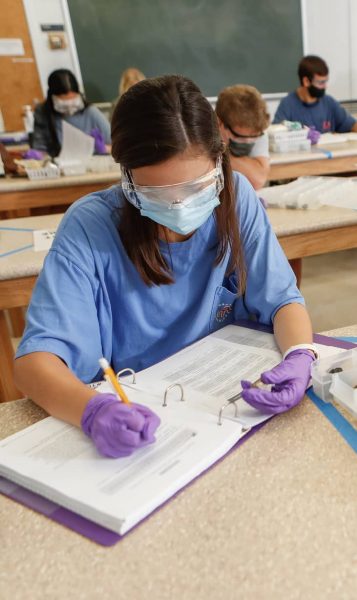Tracking an Invisible Enemy
Georgia Southern Students Battle
Coronavirus Pandemic on Campus, in the Region

For the past few months, Georgia Southern public health students have been tracking an enemy so small it’s invisible to the naked eye. An enemy so small, in fact, it can fit into the width of a human hair almost 1,000 times.
The enemy is coronavirus, and students in the Jiann-Ping Hsu College of Public Health (JPHCOPH) have been tracking its movements armed only with phones, computers and conversation skills. They’re “contact tracing,” a method of identifying people who may have come into contact with someone infected with the virus that causes COVID-19.
To help track these cases and keep campus communities safe, the University launched the CARES Center in July. CARES is a reporting center where users can self-report a confirmed or suspected positive COVID-19 diagnosis, or submit questions or issues. It has also been at the core of the University’s ability to do contact tracing on three campuses across the region.
“The basic premise of contact tracing is to ask those who have tested positive (and anyone who has been in close contact with them) to limit their contact with other people,” said Kelly Crosby, director of risk and compliance and head of the CARES Center contact notification team at Georgia Southern. “If we limit that contact, we limit the opportunities for the virus to spread.”
Crosby says the speed at which coronavirus spreads has been one of the most difficult obstacles to overcome in defeating it. Just one asymptomatic carrier can be responsible for more than a dozen infections by initially infecting only two people. When one or more of those carriers self-isolate or quarantine, however, the number of cases begins to drop exponentially.
This potential for significantly reducing the spread is why Dziyana Nazaruk, Ph.D., assistant professor of public health and internship practice liaison for JPHCOPH says these students are on the frontlines of a real war.
“Being on the frontlines and being part of the solution — I think that’s very important,” she said. “I mean, this is almost like if you are a soldier and you’re training for a war. This is a war.”
Both undergraduate and graduate public health students joined two main fronts of the battle — on campus and across the state. In May, the Georgia Department of Public Health (GDPH) asked JPHCOPH for students who could help with statewide contact tracing. By the time the students were trained and sent into action, cases in Georgia began to rise in June and then skyrocketed to more than 3,000 cases per day in July.
“We’ve seen it explode,” said Jill Johns, a Doctor of Public Health (DrPH) student from Statesboro, Georgia, who worked in the Southeast Health Region, which covers some of the hardest-hit areas in the state. “You’re in a boat with a bunch of holes drilled in the bottom and you’re scooping out cups full of water at a frantic pace, and no matter how quickly you scoop some of the water out, it just keeps filling back up. And so then we hire extra contact tracers, which basically means our cup goes from a cup to maybe like a bucket. And now we’re all bailing with buckets.”

On campus, in just the second week of classes in August, the CARES Center faced hundreds of calls just as they were setting up their notification teams. Chris Hill II, a Master of Public Health (MPH) student from Valdosta, Georgia, said his first couple of weeks were chaotic, but his team was able to get in front of the virus.
“Early in the semester, it seemed as if our team wasn’t doing a lot because it was like we could never catch up or notify people quick enough,” he said. “But now it seems like we have it under control and everything is running more smoothly.”
As of October 1, the new cases on all campuses at Georgia Southern dropped to less than 10 for the week. In Georgia, cases fell down to less than 1,200 per day. And while the numbers are moving in a good direction, students say the battle continues.
Chakaela Turner, an MPH student from Warner Robins, Georgia, started as a contact tracing intern with the GDPH and is now a full-time supervisor, where she says she’ll serve “until COVID is gone.” She says that while the investigation and identification aspects of contact tracing are still invaluable during the pandemic, the relationships contact tracers build with their clients are just as important.
For some of their clients, the contact tracer calling their home is the only contact they have with the outside world.
“”Right now, you hear a lot of what COVID is and what you need to do to protect yourself, not necessarily what you need to do to make sure your mental health is okay,” she said. “And I think that’s something that needs to be pushed a little more.”
“I celebrated birthdays with people,” said Johns. “I’ve learned all about their kids. We’ve just built a rapport with a lot of different people. And it’s fleeting, you know. You have them in your account for no more than 14 days and then, POOF!, they go away, and you’re constantly bringing in new people.”
On campus, CARES Center contact tracers not only guide students to quarantine, they help them through their time alone as well.
“We just tell them that the University is here for them and we’re going to provide them with the resources,” said Hill. “Somebody on the team will contact their professors. If they live on campus, they can get their meals delivered — just kind of letting them know that they have resources so they don’t have to be so stressed out about it.”
Several students, including Johns, have continued to serve as contact tracers long after their academic practicums have ended. For them, contact tracing isn’t just about fulfilling class credits, it’s about the fight, and it’s about the experience.
“We learn about these public health practices theoretically in our textbooks and in all of our coursework,” said Johns. “And we’re getting a chance to live and work in a public health crisis, a global pandemic, a public health crisis. That’s like a once-in-a-lifetime opportunity.”
— Doy Cave
